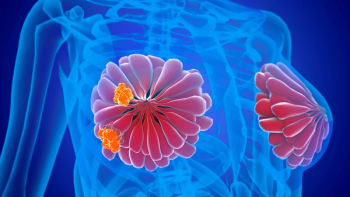
- Rx Road Map: Vorasidenib (Voranigo) for the Treatment of Astrocytoma/Oligodendroglioma
Rx Road Map: Vorasidenib for the Treatment of Astrocytoma/Oligodendroglioma
This Rx Road Map outlines the most important information nurses should know when treating patients with astrocytoma or oligodendroglioma with vorasidenib.
Who Is This Drug Approved For?
On August 6, 2024, the FDA approved vorasidenib (Voranigo), an isocitrate dehydrogenase-1 (IDH1) and isocitrate dehydrogenase-2 (IDH2) inhibitor, as first-line systemic therapy indicated for the treatment of adult and pediatric patients 12 years and older with grade 2 astrocytoma or oligodendroglioma harboring a susceptible IDH1 or IDH2 mutation after surgical procedure including gross total resection, biopsy, or sub-total resection.1
This was the FDA’s first approval of a systemic therapy for patients with IDH1– or IDH2–mutated grade 2 astrocytoma or oligodendroglioma.
What Efficacy Data Back It Up?
The efficacy and safety of vorasidenib were evaluated in 331 treatment-naive patients with grade 2 astrocytoma or oligodendroglioma harboring an IDH1 or IDH2 mutation, as part of the phase 3 INDIGO trial (NCT04164901), a randomized, multicenter, double-blind, placebo-controlled study published in The New England Journal of Medicine.2
Participants were randomized 1:1 to receive either 40 mg of vorasidenib orally once daily or placebo, continuing until disease progression or unacceptable toxicity. The median progression-free survival (PFS), measured from randomization to either radiographic disease progression (assessed by blinded independent review) or death, was 27.7 months (95% CI, 17.0-NE) in the vorasidenib arm vs 11.1 months (95% CI, 11.0-13.7) in the placebo group (hazard ratio [HR], 0.39; 95% CI, 0.27-0.56; P < .001).
The trial met its primary endpoint, imaging-based PFS, and key secondary endpoint, time to next anticancer intervention, showing that vorasidenib significantly prolonged PFS and delayed the need for subsequent interventions such as radiation or chemotherapy. With a favorable safety profile, vorasidenib represents a promising, non-cytotoxic, disease-modifying treatment option for patients with IDH-mutant grade 2 gliomas.3
How It Works
Vorasidenib is an oral, brain-penetrant small molecule that selectively inhibits mutant IDH1 and IDH2 enzymes. Mutations in the IDH1 or IDH2 genes result in a gain-of-function alteration that leads to the production of the oncometabolite 2-hydroxyglutarate (2-HG). Elevated levels of 2-HG disrupt normal cellular metabolism and epigenetic regulation, impairing cellular differentiation and contributing to tumor development and progression.3,4,5 By inhibiting the mutant IDH enzymes, vorasidenib reduces the production of 2-HG, thereby partially restoring normal cellular function and differentiation processes.3,5,6 This mechanism targets the underlying biology of IDH-mutant gliomas and offers a non-cytotoxic therapeutic approach that can delay disease progression and potentially reduce the need for more aggressive treatments such as chemotherapy or radiation.2,3
How It's Administered
Vorasidenib is an oral drug manufactured in 10-mg and 40-mg tablets and is taken orally, once daily.4 Vorasidenib tablets should be swallowed whole with water, with or without food, and should not be split, crushed, or chewed. The tablet should be taken at about the same time each day. If a dose is missed, patients should be instructed to take the missed dose as soon as they can within 6 hours, and if a dose is missed by more than 6 hours, the patient should skip the missed dose and take the next dose at the scheduled time. If vomiting occurs after taking a dose, patients should be instructed not to take a replacement dose to and take the next dose at the scheduled time on the following day.6
Recommended Dose
The recommended vorasidenib dose in adult patients is 40 mg orally once daily.1,6 The recommended vorasidenib dose in pediatric patients 12 years and older is based on body weight:
- Patients weighing ≥ 40 kg: 40 mg orally once daily
- Patients weighing < 40 kg: 20 mg orally once daily
How to Manage Associated Adverse Events
Overall, vorasidenib was associated with mainly low-grade toxic effects. However, it can cause transient, dose-related hepatotoxicity, particularly in the early weeks of treatment. Serious adverse events (AEs) related to treatment with vorasidenib were reported in only 1.8% of patients in the INDIGO trial. The most common grade 3 or higher AEs among patients treated with vorasidenib were elevated alanine aminotransferase (ALT) levels, occurring in 9.6% of patients, elevated aspartate aminotransferase (AST) in 4.2%, elevated and γ-glutamyltransferase (GGT) in 3.0%.2
Though these elevations are typically asymptomatic, isolated to ALT/AST, and reversible with dose interruption or modification, close lab monitoring of ALT/AST, total/direct bilirubin and GGT is critical to evaluate the incidence and severity of AEs.6 Liver function tests should be assessed every 2 weeks during the first 2 months of treatment, then monthly for the first 2 years of treatment. Vorasidenib should be withhold, dose reduced or discontinue based on severity, as dictated by the prescribing information.
What to Inform Patients About Before Treatment
Before initiating treatment with vorasidenib, patients should be informed about the potential risk of liver toxicity. Baseline laboratory tests are essential and should include a complete blood count (CBC) with differential, a blood chemistry panel, and liver function tests to establish a baseline for ongoing monitoring. Patients should also be advised to make lifestyle modifications prior to starting therapy, including smoking cessation, reduction of alcohol consumption, diet modification and avoidance of excessive use of potentially liver-toxic over-the-counter (OTC) medications like acetaminophen, to support overall treatment outcomes and reduce the risk of adverse effects.
Patients should be counseled on the potential for vorasidenib to interfere with hormonal contraceptives. Vorasidenib may reduce the effectiveness of oral contraceptives, potentially leading to breakthrough bleeding or unintended pregnancy.For this reason, women of reproductive potential are advised to use nonhormonal methods of contraception, such as barrier methods. Women should be advised not to breastfeed during treatment with vorasidenib and for at least 2 months after the final dose. Male patients with female partners of reproductive potential should use effective contraception during treatment and for at least 3 months after the final dose of vorasidenib. Additionally, Vorasidenib may impair fertility in both female and male patients of reproductive potential; therefore, referrals for fertility preservation should be considered before initiating treatment.
Advice for Nurses Who Administer This Agent
A comprehensive review of all medications, including over-the-counter drugs and dietary supplements, should be conducted prior to starting vorasidenib and at every visit, as the use of strong or moderate CYP1A2 inhibitors may increase plasma concentrations of vorasidenib, thereby elevating the risk of AEs.If concurrent use of a moderate CYP1A2 inhibitor is unavoidable, patients should be closely monitored for increased toxicity and the vorasidenib dosage should be adjusted accordingly.
Conversely, concomitant use of moderate CYP1A2 inducers may lower vorasidenib plasma concentration levels, potentially diminishing its anti-tumor activity.
Vorasidenib may also reduce the plasma concentrations of drugs that are CYP3A substrates, possibly decreasing their therapeutic effect. These potential interactions highlight the importance of careful medication reconciliation and monitoring throughout treatment.
How to Safely Handle Vorasidenib
Vorasidenib should be stored in its original bottle at room temperature at 20°C to 25°C (68°F to 77°F) with excursions permitted between 15°C and 30°C (59°F to 86°F).
References
- FDA approves vorasidenib for Grade 2 astrocytoma or oligodendroglioma with a susceptible IDH1 or IDH2 mutation. FDA. August 6, 2024. Accessed April 1, 2025. https://www.fda.gov/drugs/resources-information-approved-drugs/fda-approves-vorasidenib-grade-2-astrocytoma-or-oligodendroglioma-susceptible-idh1-or-idh2-mutation
- Mellinghoff IK, van den Bent MJ, Blumenthal DT, et al. Vorasidenib in IDH1- or IDH2-mutant low-grade glioma. N Engl J Med. 2023;389(7):589-601. doi:10.1056/NEJMoa2304194
- de la Fuente MI, Touat M, van den Bent MJ, et al. The role of vorasidenib in the treatment of isocitrate dehydrogenase-mutant glioma. Neuro Oncol. 2025;27(5):1135-1148. doi:10.1093/neuonc/noae259
- Dang L, White DW, Gross S, et al. Cancer-associated IDH1 mutations produce 2-hydroxyglutarate. Nature. 2009;462(7274):739-744. doi:10.1038/nature08617
- Geurts M, Blaquier JB, Wijnenga M, Kamson DO, de la Fuente MI. Incorporating targeted therapy into neuro-oncology practice. Am Soc Clin Oncol Educ Book. 2025;45(3):e473324. doi:10.1200/EDBK-25-473324
- Voranigo. Prescribing information. Servier Pharmaceuticals LLC; 2024. Accessed August 7, 2025. https://www.accessdata.fda.gov/drugsatfda_docs/label/2024/218784s000lbl.pdf
Newsletter
Knowledge is power. Don’t miss the most recent breakthroughs in cancer care.




















































































